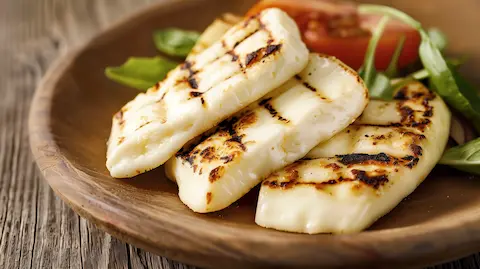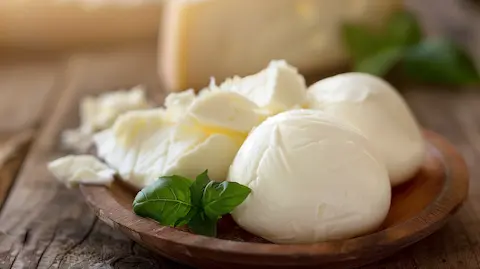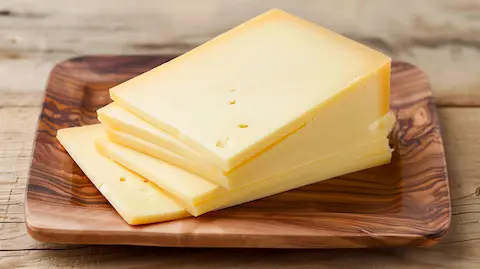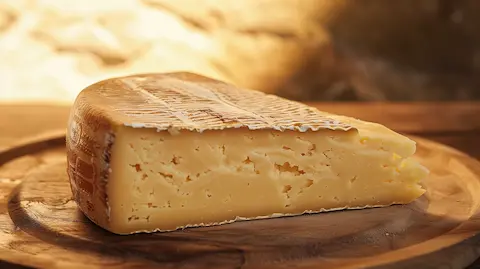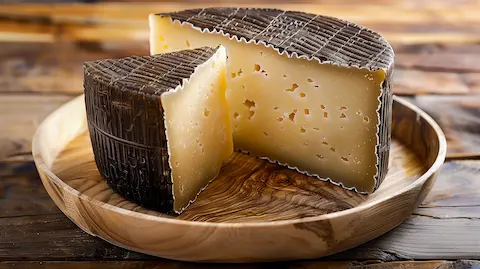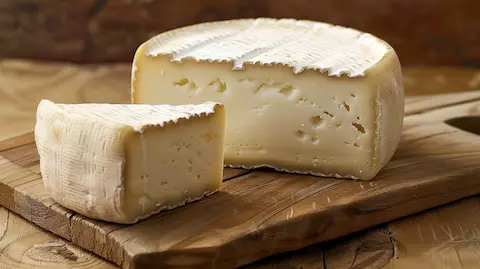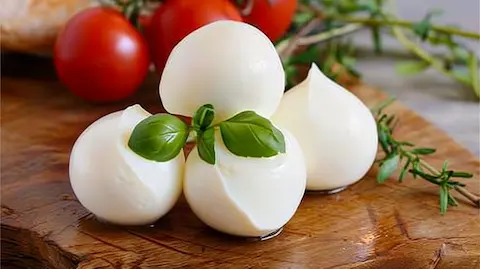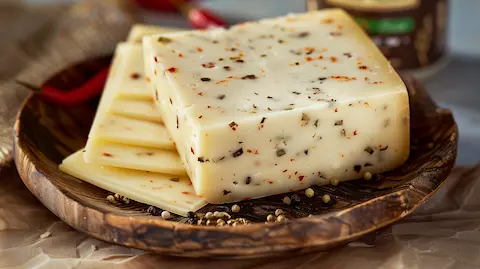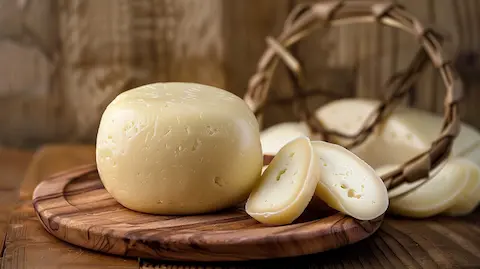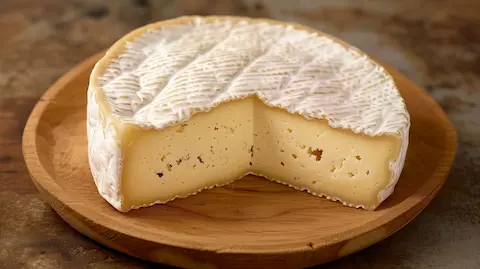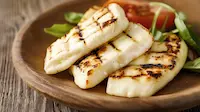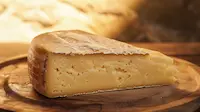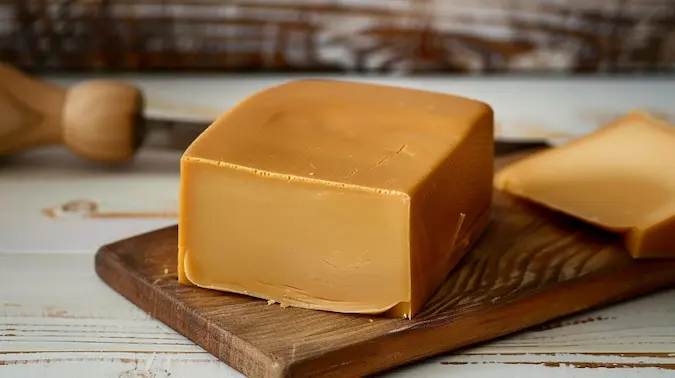Brunost cheese
Brunost is a distinctive Norwegian cheese known for its caramel-like flavor and fudge-like texture. This unique cheese comes from the whey of goat's milk, often mixed with cow's milk and cream. It boasts a rich, sweet taste due to the slow simmering process that caramelizes the milk sugars. Brunost is not just a cheese but a part of Norway's cultural heritage, with roots tracing back to its rural farms where it was first crafted for sustenance and warmth during harsh winters.
Renowned for its versatility, Brunost can be sliced over bread, waffles, or used in various culinary creations that call for a touch of sweetness. Its color ranges from light brown to dark caramel, indicating the length of cooking time and the types of milk used. Whether enjoyed at breakfast or as a snack, Brunost provides a comforting flavor that is both unique and deeply rooted in the history of Norwegian cuisine.
How is Brunost made?
Brunost cheese is made by boiling a mixture of milk, cream, and whey for several hours until it reduces to about one-fifth of its original volume. The heat causes the milk sugars to caramelize, giving the cheese its characteristic brown color and sweet flavor. Once the desired consistency is achieved, the thickened mixture is poured into molds to cool and solidify.
Here is a detailed breakdown of the production process:
Brunost Cheese Production Process
| Step | Description | Ingredients | Temperature | Duration |
|---|---|---|---|---|
| 1. Mixing | Combining goat's whey, cow's milk, and cream in a large pot. | Goat's whey, cow's milk, cream | Room temperature | |
| 2. Boiling | Slowly heating the mixture to evaporate water and concentrate flavors. | Gradually increasing to 80-95°C (176-203°F) | 2-3 hours | |
| 3. Caramelization | Continuing to heat until milk sugars caramelize and mixture thickens. | Constant at 95°C (203°F) | Several hours | |
| 4. Cooling and Molding | Pouring the thickened mixture into molds to shape and cool. | Room temperature | Until set |
What does Brunost taste like?
Brunost tastes like a harmonious blend of sweet caramel with a hint of nuttiness, complemented by a rich, creamy texture. Its flavor is reminiscent of dulce de leche or sweetened condensed milk, with a slight tanginess that adds depth and complexity to its overall profile.
Brunost cheese profile
Exploring the attributes of Brunost offers insight into its distinct identity among cheeses. Below is a profile that captures the essential characteristics of this Norwegian specialty:
- Made from: Primarily goat's whey, often combined with cow's milk and cream
- Country of origin: Norway
- Region: Produced across the country, with strong ties to rural farming communities
- Family: Whey cheese
- Type: Firm, yet sliceable with a fudge-like texture
- Texture: Dense and rich
- Rind: None
- Colour: Light to dark caramel, depending on cooking time and milk types used
- Flavour: Sweet, with hints of nuttiness and a mild tanginess
- Aroma: Mildly sweet and caramelized
- Vegetarian: No, due to the use of animal rennet
- Producers: Various, from small-scale artisanal to larger dairy operations
Brunost cheese originates from Norway, a country with a rich tradition of dairy farming and cheesemaking. Its creation is a testament to the ingenuity of Norwegian farmers who sought to utilize all parts of the milk. brunost has become a symbol of Norwegian culinary culture, enjoyed domestically and internationally for its unique flavor and texture.
How to store Brunost?
Proper storage of Brunost is vital to maintain its quality and extend its shelf life. Brunost should be kept refrigerated, ideally wrapped in wax paper or parchment to allow the cheese to breathe, and then overwrapped with plastic wrap to prevent it from drying out. This method strikes a balance between protecting the cheese from unwanted air exposure and retaining its moisture.
- Initial Wrapping: Encase Brunost in wax paper or parchment.
- Secondary Layer: Overwrap with plastic wrap to seal in freshness.
- Refrigeration: Store in the refrigerator, preferably in the cheese drawer or another cool, consistent area.
- Monitoring: Check the cheese regularly for any signs of spoilage and consume within a reasonable time frame.
How long does Brunost cheese last?
Brunost cheese has a good shelf life when stored correctly. In the fridge, it can last for several weeks, while in the freezer, it can be kept for a few months. However, freezing may affect its texture and taste. When thawed, Brunost can become crumbly and may lose some of its rich, caramel-like flavor.
| Storage Location | Shelf Life | Texture After Thawing | Taste After Thawing |
|---|---|---|---|
| Refrigerator | 3-4 weeks | ||
| Freezer | 2-3 months | Crumbly | Slight loss of flavor |
Can you freeze Brunost?
Yes, freezing Brunost is possible and can be practical for extending its shelf life. However, it's important to be aware that freezing may change the cheese's texture, making it more crumbly. While the taste might also be slightly affected, frozen Brunost is still quite suitable for use in cooked dishes where it will be melted.
Alternatives to Brunost cheese
While Brunost has a unique flavor profile that is difficult to replicate, there are other cheeses with similar attributes that can serve as substitutes. Whether you're looking to explore different tastes or simply need an alternative due to availability, the following table offers a guide to cheeses that share some characteristics with Brunost.
Brunost cheese substitutes
| Cheese | Origin | Milk Source | Texture | Flavor | Best Used In |
|---|---|---|---|---|---|
| Gjetost | Norway | Goat's milk | Firm, similar to Brunost | Sweet, caramel-like | Spreads, glazes, baking |
| Myseost | Scandinavia | Whey of cow's milk | Semi-firm | Slightly sweet, less intense than Brunost | Spreads, sandwiches |
| Prästost | Sweden | Cow's milk | Semi-hard | Mildly sweet, nutty | Snacking, cheese boards |
| Ricotta Salata | Italy | Sheep's milk whey | Firm, crumbly | Sweet, milky | Salads, grating over dishes |
| Mascarpone | Italy | Cow's milk cream | Creamy, spreadable | Sweet, buttery | Desserts, spreads |
Brunost popular comparison
Gjetost is frequently compared to Brunost, as they are both traditional Norwegian cheeses with a similar look and taste. Gjetost is made exclusively from goat's milk, which gives it an even more pronounced sweet and caramel-like flavor compared to the mixed milk Brunost.
How to use Brunost
Brunost's unique sweet and savory flavor profile makes it a versatile addition to many dishes. To cut Brunost, a cheese slicer is typically used to create thin, even slices that can be easily melted or served as is. Its melting qualities make it a superb choice for sauces and glazes, while its firmness when chilled lends itself to being a delightful topping for breads and crackers. Whether melted over warm dishes or served cold, Brunost adds a distinctive caramelized sweetness that can elevate a meal.
| Use | Description |
|---|---|
| Slicing | Use a cheese slicer to create thin, even slices for sandwiches or to top crispbread. |
| Melting | Melt into a sauce for savory dishes like meat or root vegetables, or use in sweet applications like dessert toppings. |
| Shaving | Shave over salads or cooked vegetables for a sweet and savory element. |
| Grating | Grate and sprinkle over pasta, soups, or stews for added flavor complexity. |
| Baking | Incorporate into baked goods for a caramelized, sweet note. |
| Snacking | Enjoy as a snack with fruit or nuts, or simply on its own to savor its unique taste. |
How to serve Brunost cheese
Serving Brunost involves presenting it in a way that highlights its rich and sweet flavor. It's delightful when thinly sliced and layered on warm toast or crispbread, allowing the heat to soften the cheese slightly. For a traditional Norwegian experience, pair Brunost with tart raspberry jam or honey to complement its sweetness. On a cheese board, it stands out next to milder cheeses, offering a bold contrast in both flavor and color. Accompany with fresh fruit, like apples or pears, for a balanced and satisfying cheese course.
Recipes using Brunost
Brunost's sweet and savory qualities make it a standout ingredient in various dishes. Its ability to melt smoothly allows it to blend into sauces and baked goods, while its firmness when cool provides texture and flavor to cold applications.
- Brunost Sauce for Game: The cheese's caramel notes complement the rich flavors of meats like venison and elk.
- Norwegian Waffles with Brunost: Slices of Brunost melt into the warm waffles for a sweet and savory treat.
- Brunost Ice Cream: Infusing Brunost into ice cream creates a unique dessert with a Norwegian twist.
- Brunost Mac and Cheese: Adds a Norwegian flavor to the classic dish with a sweet caramelized depth.
- Brunost Stuffed Chicken Breast: The cheese melts into the meat, providing a moist and flavorful filling.
Brunost nutrition data
There are 465 calories in Brunost cheese per 100g. This cheese is a dense source of energy, primarily from carbohydrates and fats. While Brunost provides a significant amount of protein and calcium, it also contains a high level of saturated fats, which should be considered when incorporating it into your diet.
| Nutrient | Amount per 100g | % Daily Value* |
|---|---|---|
| Calories | 465 | - |
| Total Fat | 29g | 45% |
| Saturated Fat | 19g | 95% |
| Cholesterol | 100mg | 33% |
| Sodium | 400mg | 17% |
| Total Carbohydrates | 42g | 14% |
| Dietary Fiber | 0g | 0% |
| Sugars | 30g | - |
| Protein | 10g | 20% |
| Calcium | 400mg | 40% |
*Percent Daily Values are based on a 2,000 calorie diet. Your daily values may be higher or lower depending on your calorie needs.
What's next? WhatCheese insights
If you are a cheese aficionado with a penchant for the sweet and savory notes of Brunost, finding this Norwegian delight can be a fulfilling quest. Specialty cheese shops and Nordic markets are often the best places to procure authentic Brunost. For those who prefer the convenience of online shopping, there are numerous gourmet food websites that offer a range of Brunost varieties, ensuring that even those far from Norway's shores can enjoy this unique cheese.
If you are eager to experience Brunost in a more interactive setting, keep an eye out for cheese tasting events and culinary workshops that feature Scandinavian cuisine. These gatherings are fantastic opportunities to learn about Brunost's place in Norwegian culinary traditions, discover innovative ways to incorporate it into your cooking, and connect with fellow cheese lovers who share your enthusiasm for exploring the world of cheese.
For those who relish the firm and sweet qualities of Brunost, consider trying other cheeses like Gouda, especially the aged varieties, for a similar caramelized sweetness. manchego, with its nutty undertones, and the dense, creamy Havarti also offer delightful experiences for those who enjoy the firmer cheese category.

